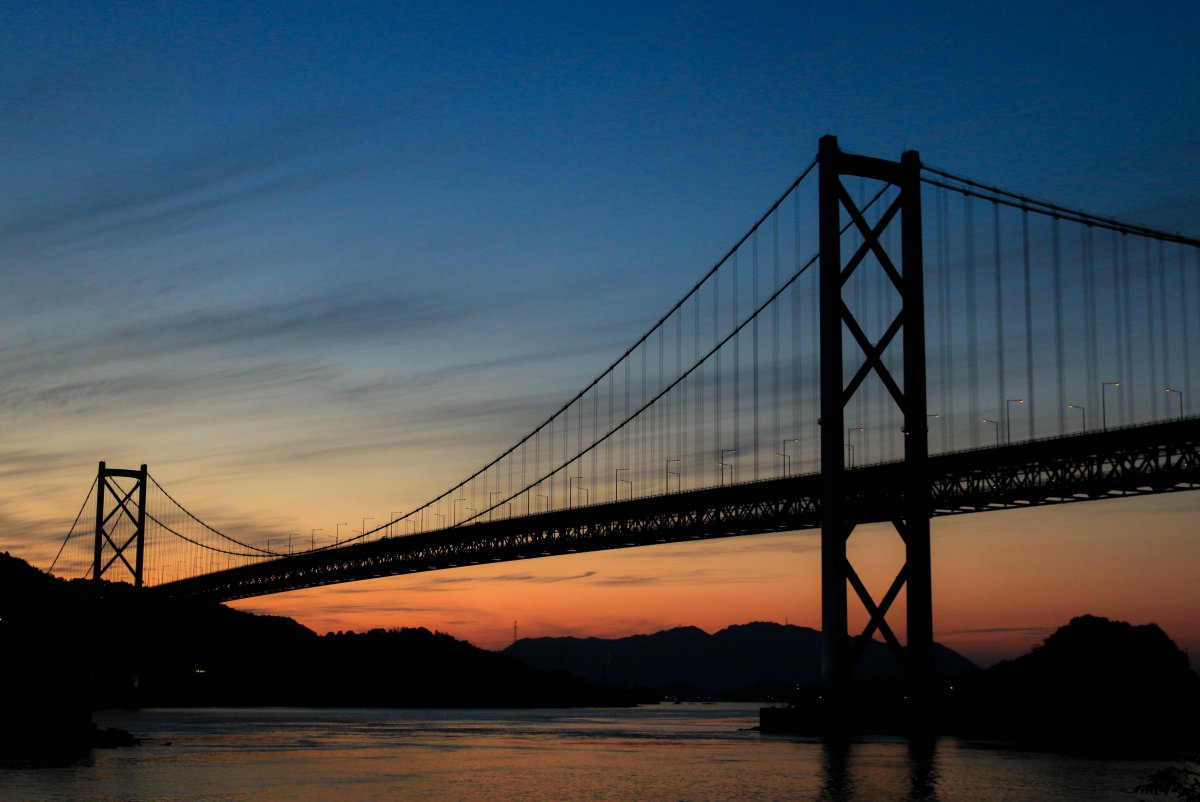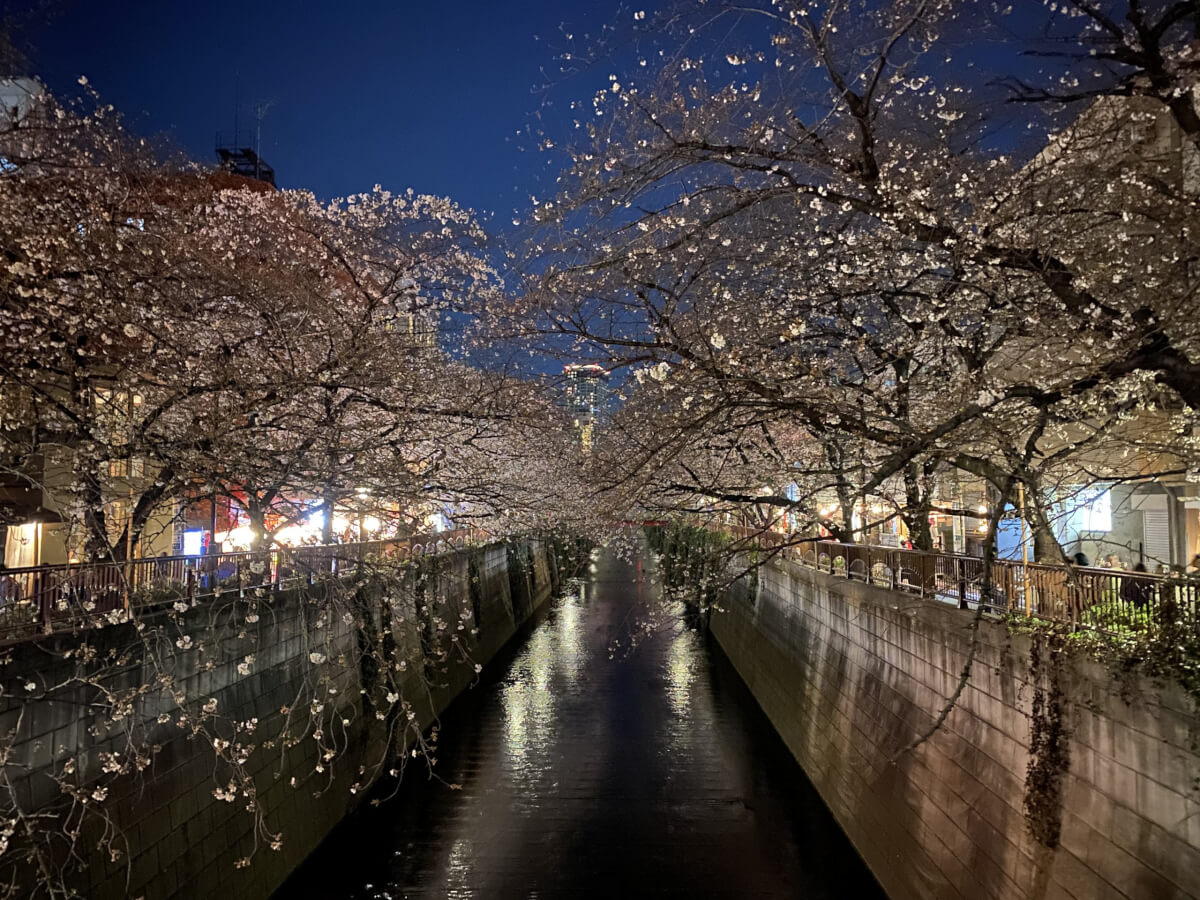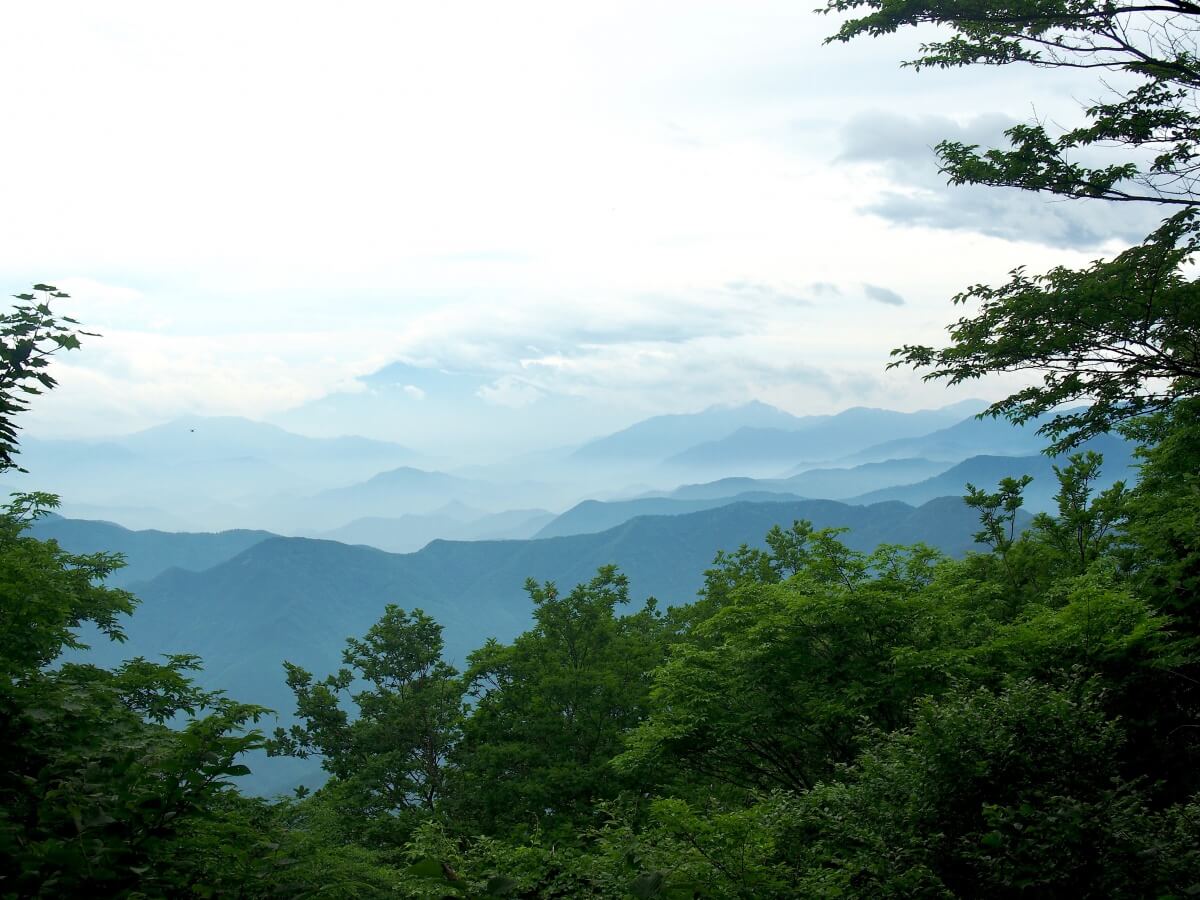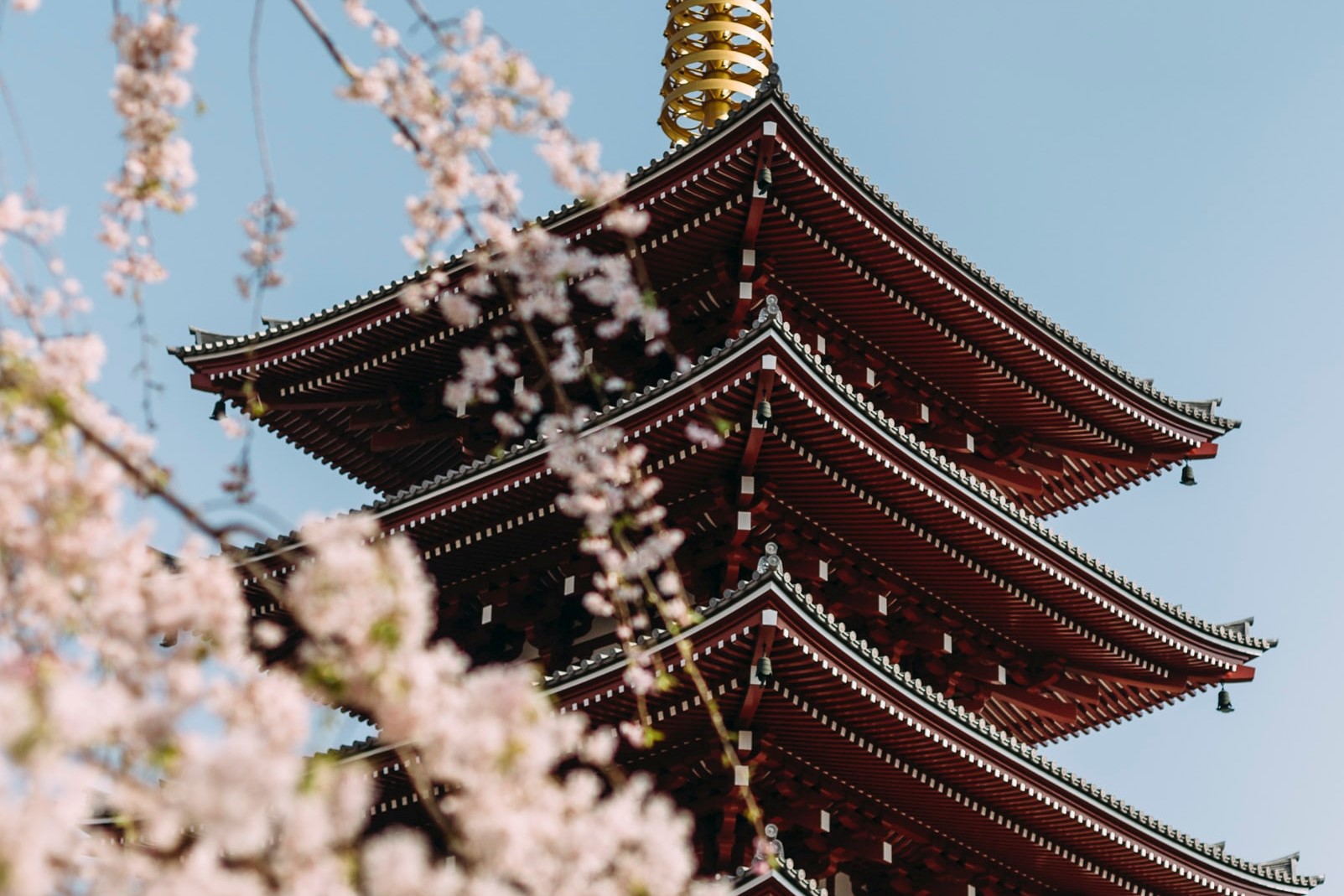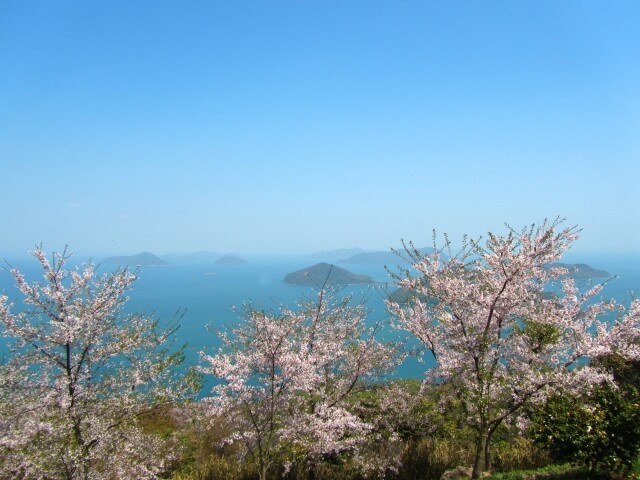Ehime (愛媛県, Ehime-ken) prefecture is located in the northwest part of the island of Shikoku. Several smaller islands in the Seto Inland Sea also belong to the Ehime Prefecture. The prefectural capital is Matsuyama, best known for Dogo Onsen, one of Japan’s oldest onsen resorts that also served as an inspiration for the Ghibli movie Spirited Away. Ehime prefecture is also referred to as the Land of the Mikans (oranges), blessed with warm and sunny weather all throughout the year, the area is a paradise for citrus fruits! Besides the juicy, sweet mikan, Ehime is known for its castles, onsen resort, the world’s longest suspension bridge, historical shrines and temples, and several spots for scenic views. Here we introduce you to the best places to visit in Ehime.
1. Dogo Onsen
This onsen resort, located in Matsuyama, is one of the oldest in Japan with 3,000 years of history. The main attraction of Dogo Onsen is Dogo Onsen Honkan, a wooden public bathhouse, dating from 1894. This three-level wooden building topped by a watchtower with red glass window and a decorative metal heron, is said to have served as inspiration for Hayao Miyazaki’s animated film Spirited Away.
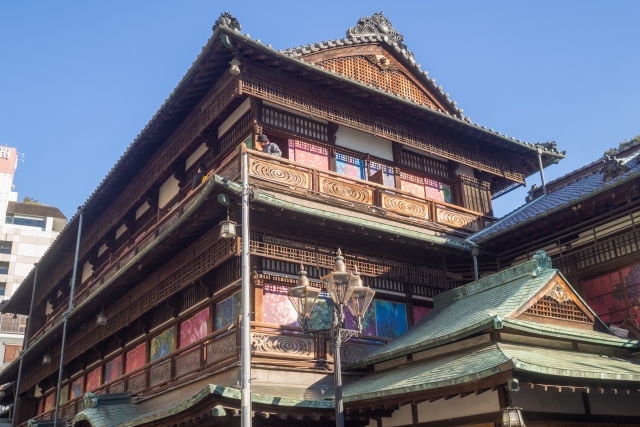
Besides the famous Ghibli bathhouse, there are many other spots to enjoy. Asuka-no-yu,opened in 2017, is the modern version of Dogo Onsen Honkan, and Tsubaki-no-yu is a stylish and modern bathhouse with the mineral-rich water that leaves your skin silky soft. Dogo’s shopping arcades offer many places to find local souvenirs, and the Masaoka Shiki Museum exhibits the works of poems and paintings of the father of modern haiku poetry.
How to access Dogo Onsen
- From JR Matsuyama station, take tram #5 to Dogo Onsen station (~20 min)
- From Matsuyama-shi station, take tram #3 to Dogo Onsen station (~15 min)
2. Kurushima Bridge
Kurushima Bridge or Kurushima Kaikyo Bridge connects the island of Oshima to Shikoku Island. Completed in 1999, the 4-km-long Kurushima Bridge is the world’s longest suspension bridge structure! In the evening, the bridge is beautifully illuminated.
Kurushima Bridge is part of a the 60-km-long toll road Shimanami Kaido, passing over six small islands in the Seto Inland Sea. A popular way to experiencing the Shimanami Kaido and it’s Hawaiianesque surrounding is by bicycle. You can cycle parts of the toll road or the full 60 km, it can be completed in one day!
One of the best spots where you can enjoy a spectacular view of the bridge is Itoyama Park in Imabari City. There are two observatories in Itoyama Park that offer a panoramic view of the bridge. In early mornings from March to July, the bridge appears to be floating on a sea of clouds.
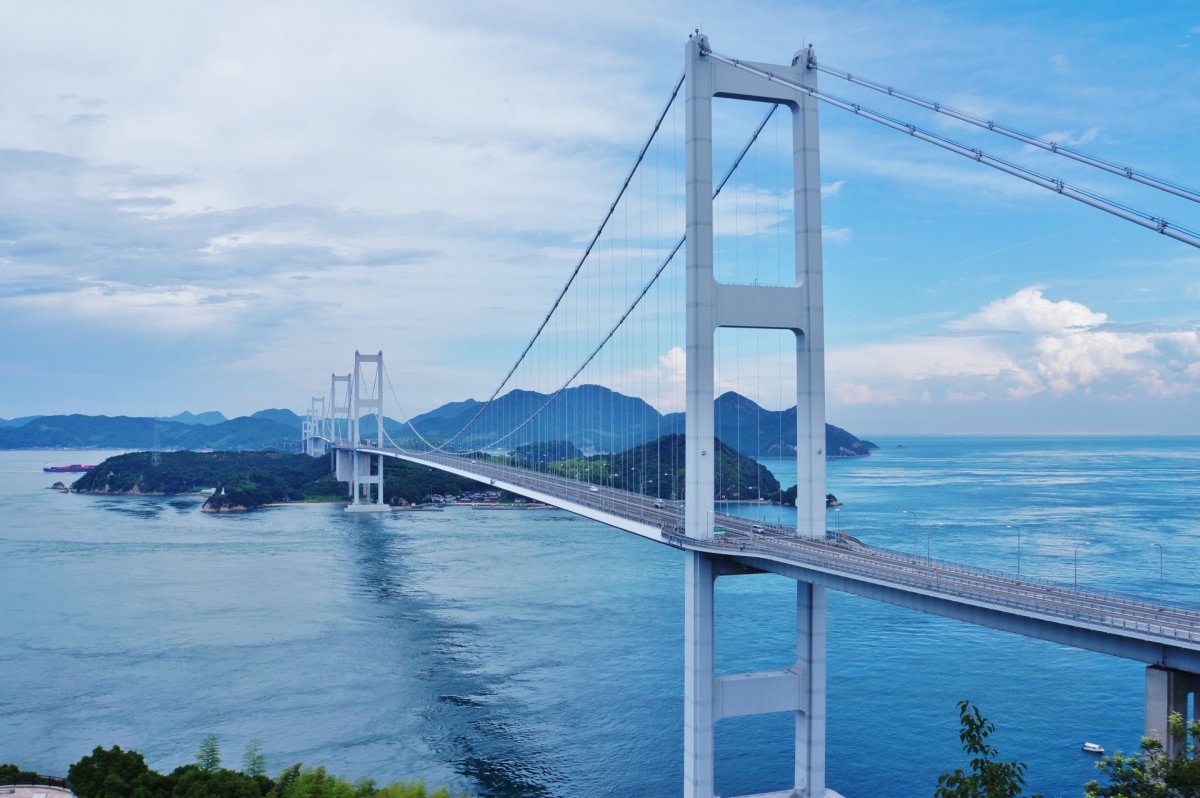
How to access Itoyama Park
From JR Imabari station, take Setouchi Bus bound for Ohama, get off at Tenbodai Iriguchi bus stop (~20 min).
3. Matsuyama Castle (松山城)
Matsuyama Castle or Matsuyamajō, is one of Japan’s 12 original castles, meaning that it dates back to before the Edo period and survived the the post-feudal era. The castle is located on Mount Katsuyama in the center of Matsuyama. The castle is an excellent example of a feudal castle with the main circle of defense, called Honmaru, being located on the top of the hill. On either side of the main keep, there are smaller towers which are all connected to defend the main keep. The castle grounds offers a large space for picnicking, especially in spring where the Sakura are in full blossom, Matsuyama Castle grounds are yet another prime hanami spot!
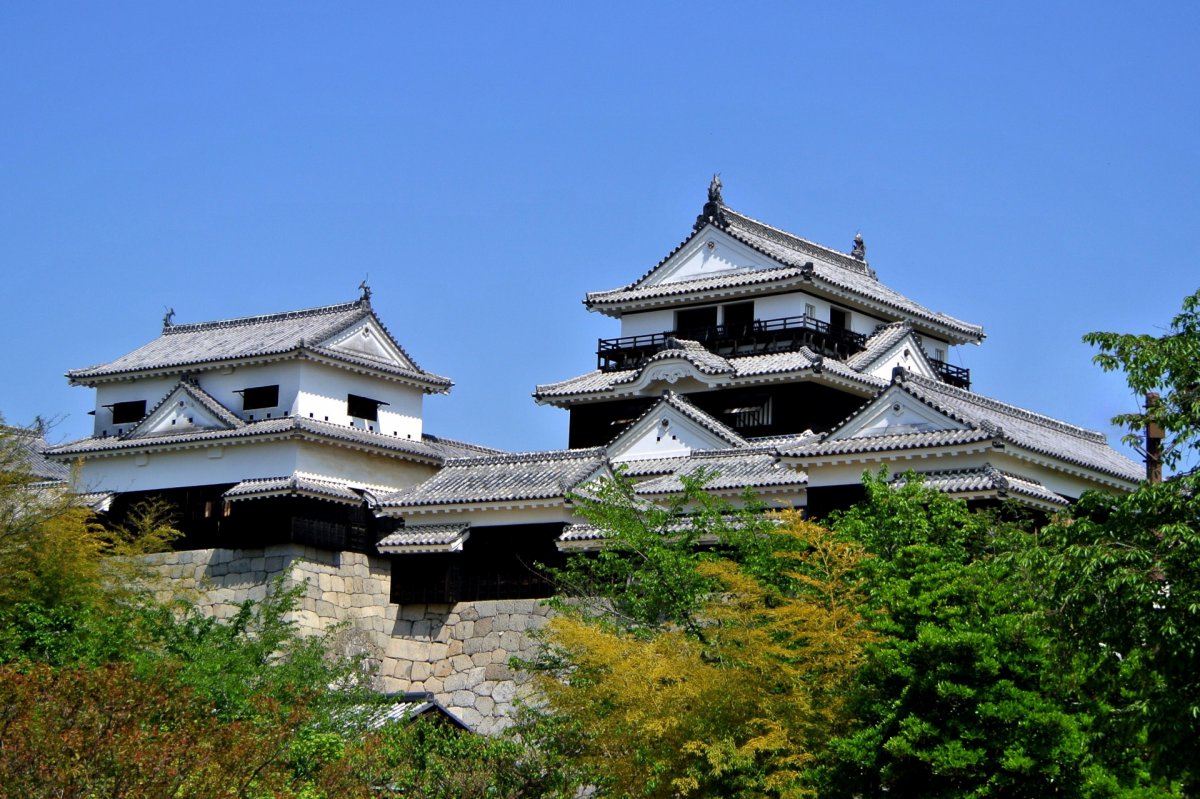
Matsuyama Castle
Hours: 9am – 5pm
Admissions ¥520
How to access Matsuyama Castle
The castle can be accessed by ropeway or chairlift. From JR Matsuyama station, take a tram #5, get off at Okaido station (~10 min). Or board tram #2 or #3 from Matsuyama-shi station (~5 min). Walk for about 5 min to the ropeway and chairlift stations that will bring you to the top.
Matsuyama Castle Ropeway & Chairlift
Hours: 8.30am – 5pm / 5.30pm
Admission ¥520 (round trip)
4. Mount Ishizuchi (石鎚山)
With 1,982 meter in height, Mount Ishizuchi, has the highest peak on the island of Shikoku and in western Japan. Mount Ishizuchi is an important object of worship in the region and one of the seven sacred peaks of Japan. At the top of the mountains, a small shrine called the Ishizuchi Shrine can be found. The sharp rocks at the summit earned the mountain its nickname the Stone Hammer. The mountain is beautiful all year round, but especially in autumn with the rich fall colours. But of course that also means that the trails become busier.
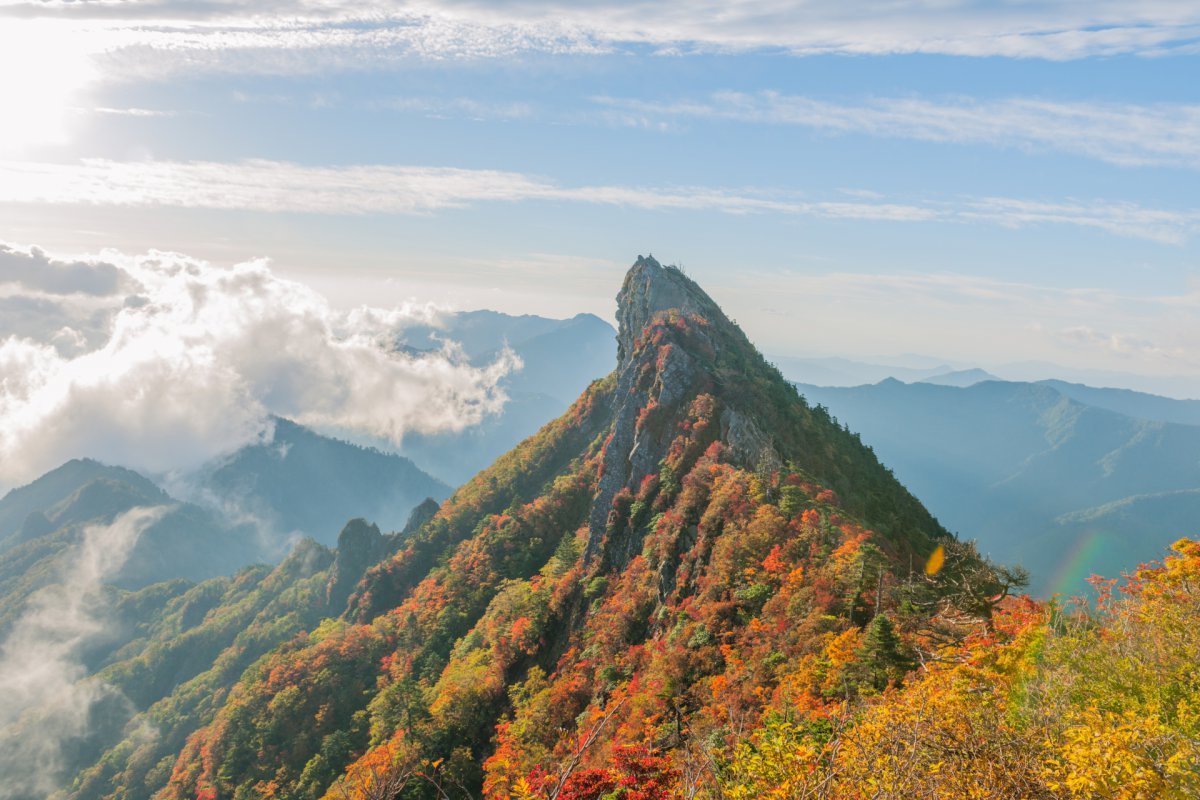
A variety of walking trails are available including the 4.6 km ridge walk Tsuchi-goya Hut course, starting at Kumakogen-cho, or start with a cable car ride from Saijo-shi followed by the 3.6 km Omote Sando (Joju) hike. There are also some challenging trails with several sets of iron chains vertically leading up to the summit. However, it is also possible to hike all the way to the peak following a trail that includes stairs and ramps with handrails.
The climbing season opens on July 1, and women cannot climb the mountain on this day because of an ancient mountain opening ceremony.
Mount Ishizuchi hiking trails map
How to access Mount Ishizuchi
It requires some careful planning to visit the area by public transportation, your best option is a (rental) car.
- For the Omote Sando trail; take a bus from JR Iyo-Saijo station and get off at the Ropeway-mae bus stop.
- For the Tsuchi-goya hut; public transport is only available during hiking season on weekends and public holidays.
5. Ishiteji Temple
Located in Matsuyama, Ishiteji Temple is the Temple 51 on the Shikoku 88 temple pilgrimage. The temple is home to a number of famous structures such as Niomon Gate, a designated national treasure. At each side of the gate, you can see two giant straw sandals, which are said to cure leg injuries.
Behind the main temple hall, you can also find a cave housing many carved and drawn Buddhist statues. Outside the cave, there is the second hidden temple, a large, golden dome-shaped hall. On top of the hill above the temple, there is a huge statue of Kobo Daishi, the founder of Japanese Buddhism.
How to access Ishiteji Temple
From JR Matsuyama station, take tram #5 to Dogo Onsen and walk about 15 min.
6. Oyamazumi Shrine
Oyamazumi Shrine is located on the island of Oshima in the Seto Inland Sea, connected to Shikoku Island by the Kurushima Bridge. The holy pilgrimage destination is dedicated to the deities protecting sailors and soldiers, and the head shrine of approximately 10,000 Yamazumi and Mishima shrines across Japan. A huge sacred camphor tree, which is estimated approximately 3,000 years old, stands in the center of the shrine ground. The shrine is well known for its impressive collection of samurai armor and weaponry which were offered by many samurai who would stop here and pray for success in battle, or thank for a victory. The collection can be viewed in the Homotsukan, the shrine’s museum.
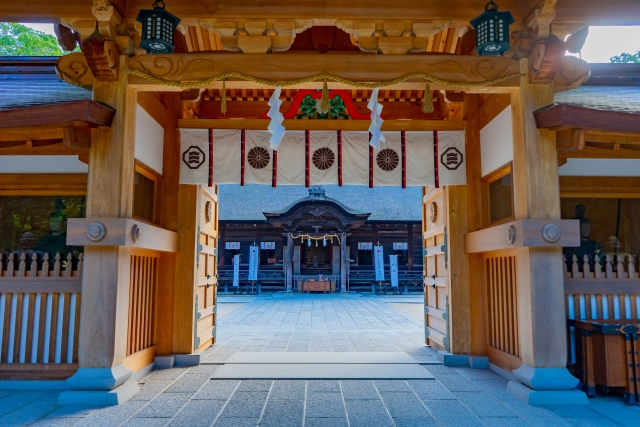
Oyamazumi Shrine
8.30am – 5.30pm
Free admission (entry to the shrine’s museum is ¥1,000)
How to access Oyamazumi Shrine
From JR Imabari station, take the bus bound for Omishima, get off at Oyamazumi-jinja-mae bus stop (~1 hr).
7. Shimonada Station
This is one of the railway stations on the JR Shikoku Yosan Line which connects Takamatsu Station in Kagawa Prefecture and Uwajima Station in Ehime. The station is located in front of the Seto Inland Sea, and a very popular spot for taking a picture of the ocean. The views are spectacular at any time from the daytime to the golden sunset, making it a famous movie set location.
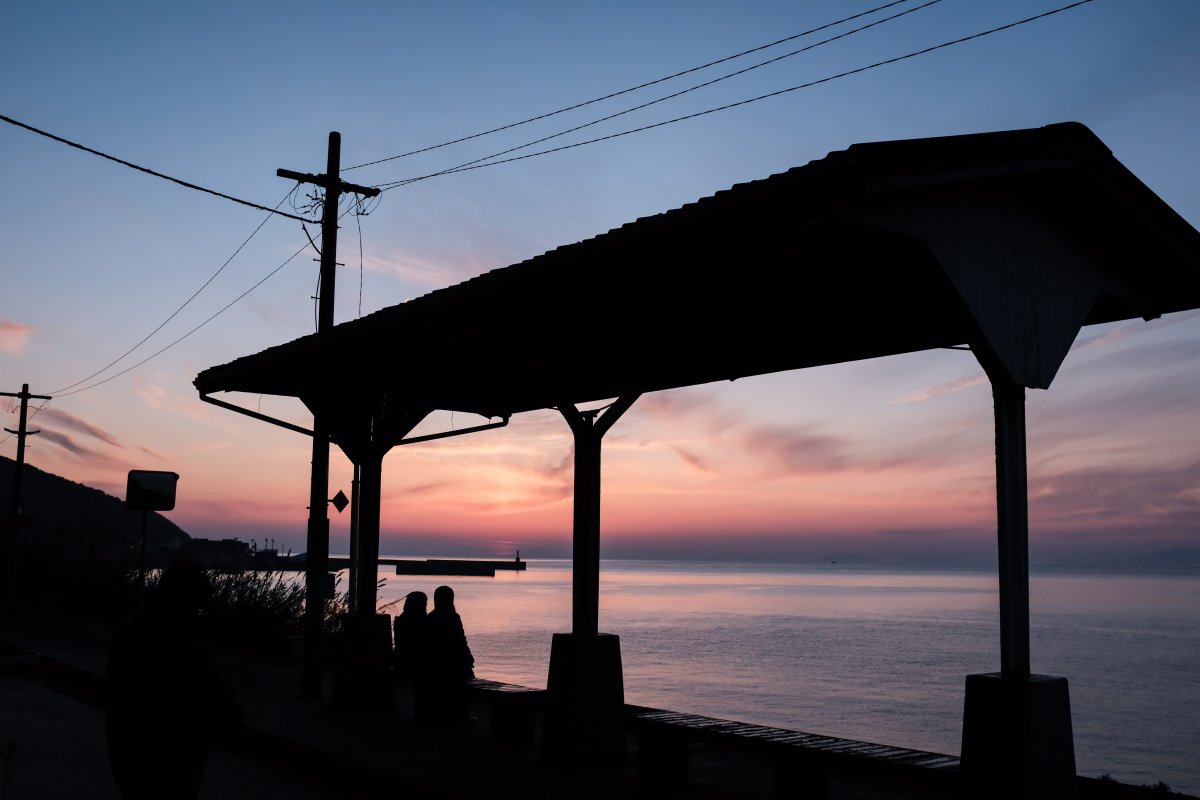
How to access Shimonada station
From Matsuyama station, take JR Yosan Line for about 45 min.
8. Shikoku Karst
Shikoku is one of Japan’s three greatest karsts, a geological formation caused by the erosion of limestone hillsides. Shikoku Karst highlands extends approximately 25 km, from 1,000 m to 1,485 m above sea level. From spring to autumn, this is the perfect place to enjoy driving, hiking, cycling, comping and other outdoor activities. You can find cows relaxing or feeding on a meadow up close. The view from the top is spectacular!
The Ehime Prefectural Route 383 crosses 25 km on the vast plateau from east to west and is also known as the road of the sky. It offers panoramic views of the highlands and fascinating flora, fauna and rocky outcrops. During summer, the area is also popular for outdoor activities such as hiking and camping (there are also some guesthouses). Because there are just a few buildings in this area there is not much light pollution, making it a perfect spot for stargazing at night.
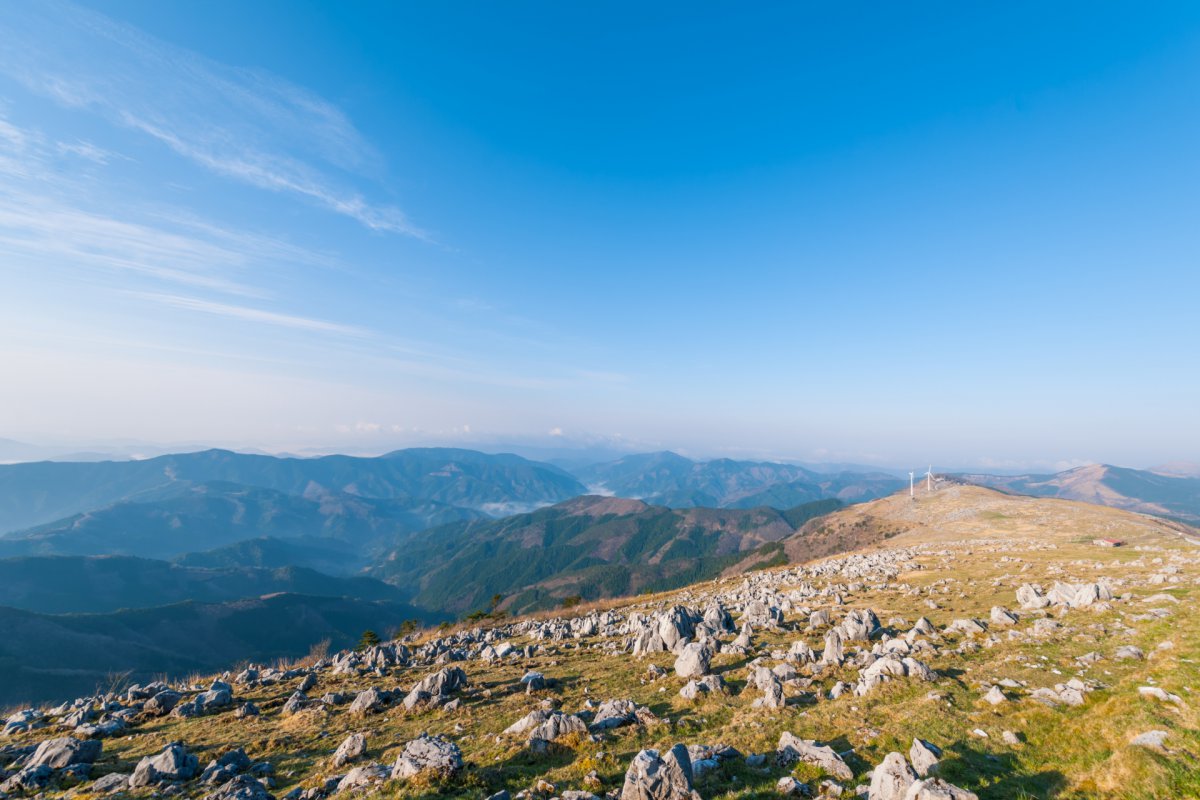
How to access Shikoku Karst
The best way to get to the Shikoku Karst is to rent a car (the drive alone is already exhilarating).
9. Imabari Castle
Imabari Castle, the landmark of the city of Imabari, dates originally from 1604. This is one of the three castles in Japan to use the sea water from a nearby port to fill the moat. In the moat, you can see some seawater fish swimming and jumping, and the water level rises with the tide.
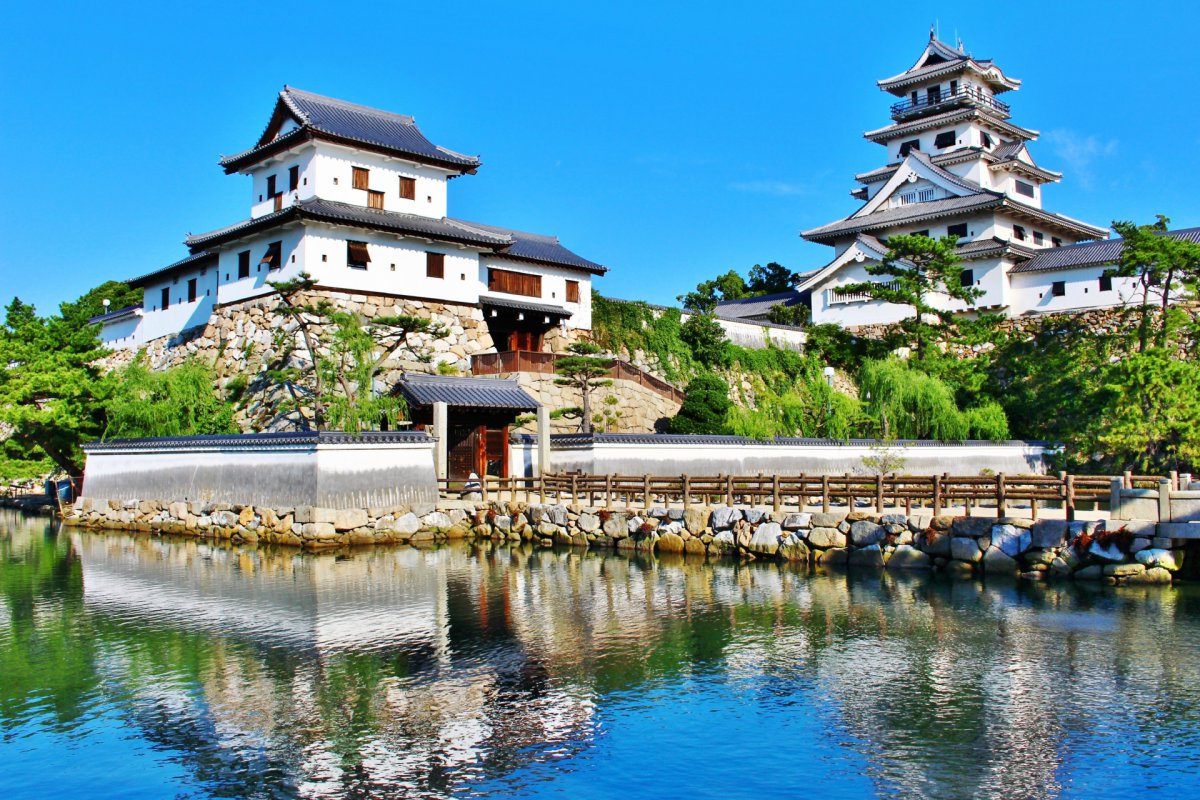
The castle keep was reconstructed in 1980, and several more turrets and a gate have been rebuilt using traditional material. The castle has a large collection of armor, weapons, and artifacts related to samurai life and culture. The top of the keep offers magnificent views of the city, the Kurushima Strait, the Shimanami Kaido Bridge and an expanse of the Seto Inland Sea.
How to access Imabari Castle
From JR Imabari station, take a Setouchi bus bound for Imabari Eigyosho, and get off at Imabari-jo-mae bus stop (about 10 min).
10. Towel Museum Ichihiro
This museum sits in the mountains outside the city of Imabari, which has a long history of producing towels. It is said that the Towel Museum Ichihiro is the world’s first towel museum dedicated to the art towel production.
Inside the museum, you will find a gallery displaying the towel-making process from start to finish, along with various artworks made of towels. There are also three-story shops selling towels, clothing, and other locally produced products. This is a perfect place to find some gifts to take home.
Towel Museum Ichihiro
9am – 6pm
Admission ¥800
How to access the Towel Museum Ichihiro
For a visit to the towel museum, it is recommend to rent a car as it cannot be reached by public transportation. You will need to take a taxi (about 25 min) from Imabari station.
Where to stay in Ehime
- Tenguso – a beautiful guesthouse located on top of a mountain near Shikoku Karst.
- Dormy Inn Matsuyama Natural Hot Spring – a Japanese-style hotel with western beds and a large onsen
- Imabari Kokusai Hotel – a great place to relax after a full day of cycling the Shimanami Kaido, large rooms, indoor pool and beautiful views.
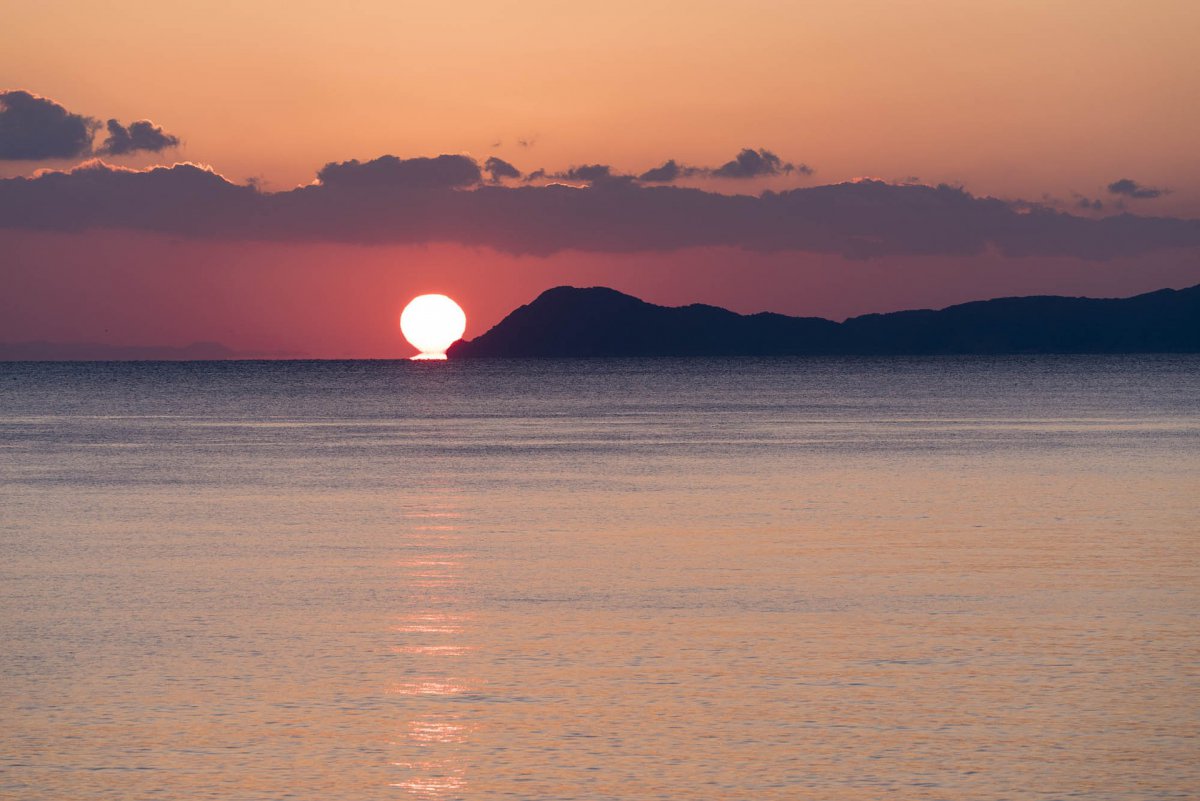
What did you think about our list of best places to visit in Ehime? We hope it helps you to plan your next trip to Ehime and the island of Shikoku. If you need any help with planning your trip to Ehime, or Japan, feel free to contact us. We’d be happy to help you with the perfect itinerary!
Follow us on Instagram or Facebook for more travel inspiration. Or tag us to get featured!
Happy travelling!
Other articles that you might like
This post may contain some affiliate links. When you click through and make a purchase we may receive some commission, at no extra costs to you
